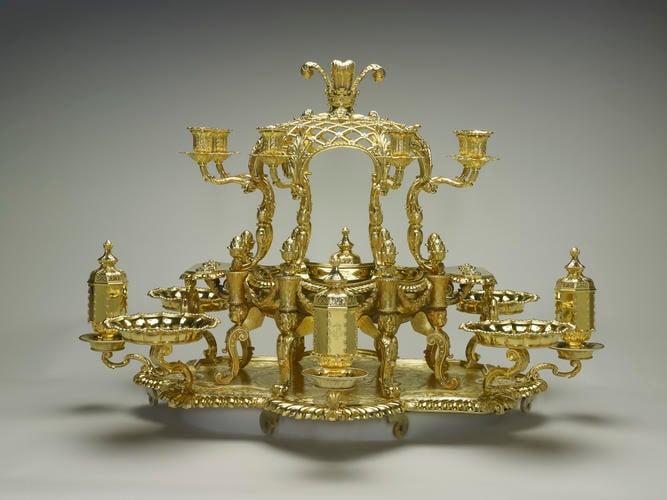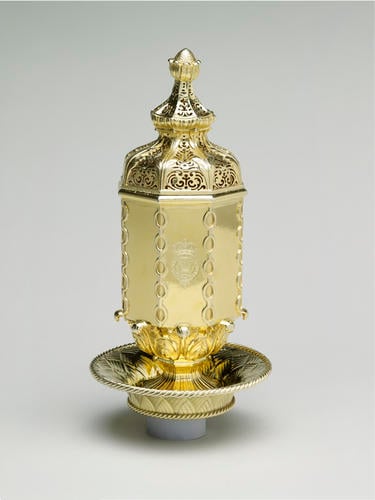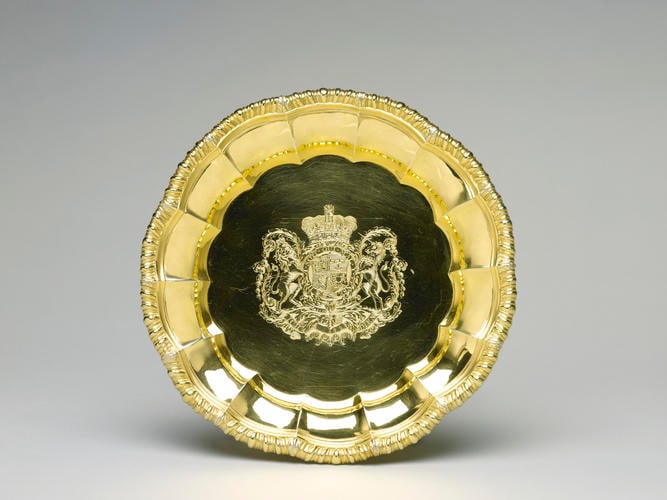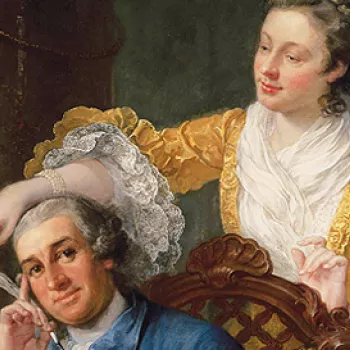Epergne with later additions of 1828/9
Silver gilt | 72.5 x 75.5 x 48 cm (whole object) | RCIN 50845

George Wickes (1698-1761)
Epergne with later additions of 1828/9

George Wickes (1698-1761)
Epergne with later additions of 1828/9

George Wickes (1698-1761)
Epergne with later additions of 1828/9

George Wickes (1698-1761)
Epergne with later additions of 1828/9

George Wickes (1698-1761)
Epergne with later additions of 1828/9

George Wickes (1698-1761)
Epergne with later additions of 1828/9






-
A large silver-gilt epergne. The lattice frame is surmounted by cast Prince of Wales feathers and supports eight short scroll branches with acanthus candle sockets and drip pans. The lobed central dish within the frame is supported on eight winged putti heads and scroll legs, each with a pine cone finial. The lower shaped stand, elaborately engraved with the coat of arms of Frederick, Prince of Wales, supports four lobed dishes on scroll arms and four scroll supports for octagonal sugar casters. The whole stands on two legs in the form of tritons blowing conch shells (after Bernini) and two further legs, one cast as a lion, the other as a unicorn. The legs are joined by swags of shells and coral branches.
In his Anecdotes of Painting in England Horace Walpole said of William Kent that his “style however predominated authoritatively during his life; and his oracle was so much consulted by all who affected taste, that nothing was thought compleat without his assistance. He was not only consulted for furniture… but for plate”. Kent is known to have designed a number of works in silver. The most celebrated piece was undoubtedly the chandelier designed for George II for his palace at Herrenhausen, but he also worked on smaller items such as mugs and dish-covers, tureens, candlesticks and inkstands. A number of Kent’s ideas for items of plate appear in John Vardy’s 1744 publication, Some designs of Mr Inigo Jones and Mr Wm. Kent, including the original design for this ‘surtoute’ or centrepiece. The published design does not show the Prince of Wales’ feathers which appear on the finished piece, which suggests that it was conceived with no particular client in mind.
At some stage, perhaps while Vardy’s book was in production, this design was realised in silver by George Wickes, goldsmith to Frederick, Prince of Wales; the resulting centrepiece is hallmarked for the year 1744/5. Although restrained in style, the design must rank as one of the most rococo of all Kent’s works. Wickes made adjustments to the design by, for example, adding candle branches, and later alterations were made to the piece in the nineteenth century. Kent also included a sauceboat in his drawing, although it seems it was never created. In spite of these changes, the essence of Kent’s design survives in the finished work, in the airy central trellis, the swagged and scalloped central dish, the shaped base plate, the scrolled uprights and particularly in the winged term figures with putti heads. It is even possible that Kent was further involved in this development stage of his original design, in collaboration with Wickes. The base plate in the finished work bears an engraved coat of arms of the highest quality; the work has not been attributed to any contemporary engraver and it has been suggested that the acanthus scrolls which surround the arms may be the design of Kent.
It has been proposed that this light-hearted piece, with its associations with a garden and its putti, may have been intended for use in the Prince’s supper box at Vauxhall.
Text adapted from The First Georgians; Art and Monarchy 1714 - 1760, London, 2014.Provenance
Delivered to Frederick, Prince of Wales in November 1745 for £695 14s 4d. The candle branches, nozzles, saucer dishes for the casters and the lower legs (lion, unicorns and tritons) were added by Rundell, Bridge and Rundell for George IV in 1829; the swags and rockwork mounts for the lion, unicorn and tritons, and the gadrooned rim of the engraved plate, were added by the firm of Garrard & Co. in 1874/5.
-
Creator(s)
(silversmith)(silversmith)(designer)(goldsmith)Acquirer(s)
-
Medium and techniques
Silver gilt
Measurements
72.5 x 75.5 x 48 cm (whole object)








